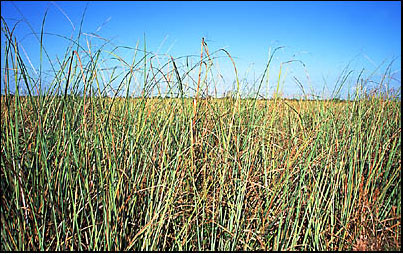Saw-grass
Cladium jamaicense
Family: Cyperaceae
Natural History

Saw-grass forms a "river of grass" in the Everglades
Photo credit: Larry Korhnak, University of Florida
Saw-grass is so named because it has spiny, serrated leaf blades that resemble a saw. It is the species that inspired the phrase 'river of grass' and is often referred to as Everglades river grass. Saw-grass is actually a sedge, not a true grass. Sedges have triangular-shaped stems whereas true grasses have round stems. Saw-grass grows in dense, uniform stands that may cover large areas. The plant spreads by underground stems and forms thick, often impenetrable concentrations that can become a problem as they clog waterways and prevent navigation and water flow.
While the coarse texture and sharp-toothed leaf blades of the plant make it difficult and even hazardous to be near, many wildlife species utilize saw-grass for both food and shelter. Migrating ducks and geese consume the seeds as a high-energy food source. Saw-grass provides cover and nesting sites for numerous birds, reptiles, and amphibians.
Saw-grass is found primarily in southeastern coastal areas from Virginia to Florida and as far west as the Texas Gulf coast. It is most abundant across large areas in southern Florida where shallow soils cover limerock and there is standing or slow moving water. Wildfires spread quickly in saw-grass even with standing water present, but saw-grass rapidly resprouts from the roots or underwater stems.
